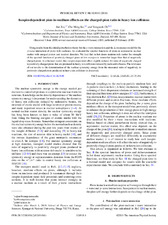| dc.creator | Xu, Jun | |
| dc.creator | Ko, Che Ming | |
| dc.creator | Oh, Yongseok. | |
| dc.date.accessioned | 2011-09-13T21:27:08Z | |
| dc.date.available | 2011-09-13T21:27:08Z | |
| dc.date.issued | 2010 | |
| dc.identifier.citation | Jun Xu, Che Ming Ko and Yongseok Oh. Phys.Rev.C 81 024910 2010. "Copyright (2010) by the American Physical Society." | en |
| dc.identifier.uri | http://dx.doi.org/10.1103/PhysRevC.81.024910 | |
| dc.identifier.uri | https://hdl.handle.net/1969.1/127099 | |
| dc.description | Journals published by the American Physical Society can be found at http://publish.aps.org/ | en |
| dc.description.abstract | Using results from the chiral perturbation theory for the s-wave interaction and the Delta-resonance model for the p-wave interaction of pions with nucleons, we evaluated the spectral functions of pions in asymmetric nuclear matter with unequal proton and neutron densities. We find that in hot dense neutron-rich matter the strength of the spectral function of positively charged pions at low energies is somewhat larger than that of negatively charged pions. In a thermal model, this isospin-dependent effect slightly reduces the ratio of negatively charged to positively charged pions that are produced in heavy ion collisions induced by radioactive beams. The relevance of our results to the determination of the nuclear symmetry energy from the measured ratio of negatively to positively charged pions produced in heavy ion collisions is discussed. | en |
| dc.language.iso | en | |
| dc.publisher | American Physical Society | |
| dc.subject | SUPERDENSE HADRONIC MATTER | en |
| dc.subject | NUCLEAR-MATTER | en |
| dc.subject | ASYMMETRIC MATTER | en |
| dc.subject | TRANSPORT | en |
| dc.subject | MODEL | en |
| dc.subject | ENERGY | en |
| dc.subject | DELTA(1232) | en |
| dc.subject | PHYSICS | en |
| dc.title | Isospin-dependent pion in-medium effects on the charged-pion ratio in heavy ion collisions | en |
| dc.type | Article | en |
| local.department | Physics and Astronomy | en |


